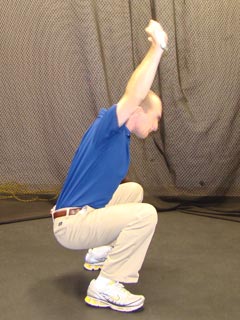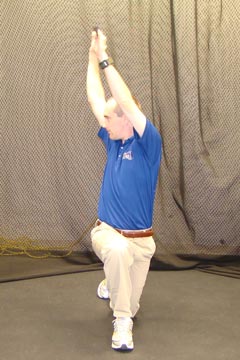Is your body helping you play the best golf possible? Do you want to feel better and play better golf?
The Golf Fitness Handicap Testing can tell you how.
Golf Fitness Handicap is a series of body movement tests that tell a story about how your body works in golf swing. It also shows how you might be at risk for an injury from golf. Each test is worth a maximum of three points. If you pass the test you get a zero and if you fail you get a three. There are 12 tests in all. Test yourself and tell us the results. We can help you improve your golf fitness handicap.
Pelvic Tilt Test


Do the test: Arch and flex your lower back and pelvis. Is the movement like the pictures? Is it shaky or solid? If your movement looks like the pictures and does not shake, you get a zero. Otherwise you get a three.
What it means: How does your lumbar spine and core affect your stability? Does your glute and abdominal control your pelvis and create STABILITY in your swing? If you lose posture during your swing, a challenged pelvic tilt test could be a contributing to the loss of posture.
Pelvic Rotation Test


Do the test: Turn your lower body and keep your upper body perfectly still. If you do this and the lower body rotates as opposed to sideways motion, you pass and get a zero. If not you get a three.
What it means: Can you rotate your pelvis independently from your upper torso and ribcage. If not, consistent, powerful rotation could be compromised. You might slide or sway, suffer from early hip extension, rotate poorly, lose posture, or chicken wing.
Torso Rotation Test


Do the test: Turn you upper body and keep you lower body perfectly still. If you do this and the upper body rotates as opposed to sideways motion, you pass and get a zero. If not you get a three.
What it means: Can you rotate your upper torso and ribcage independently from your pelvis. If not, you could have limited mobility in the thoracic spine or poor stability in the pelvis and low back. This can lead to loss of posture, slides and sways, reverse spine angle (the number one injury inducing swing fault in golf) and flipping the club.
Overhead Deep Squat


Do the test: Put a golf club over your head, and squat. Do your heels come up? Do your hips get below your knees? Does the club get in front of your feet? If any of these happen, you get a 3. If the form looks just like the picture below, you get a zero.
What it means: For sure, this test is telling you about your swing. Data indicates that when a golfer cannot do the overhead deep squat correctly, they will experience early hip extension every time. Ever feel stuck, or trapped? Have difficulty rotating through impact? That is probably early hip extension in action. Fix the squat form, and your golf swing will improve.
Toe Touch Test


Do the test: Put your feet together. Bend over and reach for your toes. Your knees need to be kept straight. Do you touch your toes with straight knees? You get a zero. Otherwise you get a three.
What it means: Golfers who cannot touch their toes will suffer from loss of spine posture. It could be your hamstrings, or your glutes, or your abs, or your hip mobility. Failed toe touch will lead to inconsistency and challenges with ball striking.
90/90 Shoulder Rotation Test


Do the test:Start in the position shown on the left picture. Now roll your arms up. If your hands get past your ears you get a zero, otherwise you get a three.
What it means: Tour players average more than 110 degrees of shoulder external rotation. Golfers who do not have at least 90 degrees of this motion can suffer flying elbows, reverse spine angles, loss of posture, over-the-top motion and possible shoulder pain. You could also be a slicer because of this shoulder problem.
Single Leg Balance

Do the test: Stand on one leg as shown. Can you make 15 seconds with your eyes closed and no wobbles? If you do that on both legs you get a zero, otherwise you get a three.
What it means: Standing on one leg tests your proprioception systems, balance systems, and core and lower extremity strength and stability. It affects your weight shift too.
Lat Test


Do the test: Stand as shown in the left picture below. Now flatten your back and lower your arms. If you keep your back flat, elbows straight AND touch the wall overhead, you get a zero, otherwise you get a three.
What it means: This is a test of lat mobility and trunk stability. It is a component of the overhead deep squat. When the lats do not work right, we see a failed overhead deep squat. The Lat Test is linked to loss of posture, early hip extension, and limited shoulder motion.
Half Kneeling Rotation


Do the test: Get into a half-kneeling position. Put the club behind your back. Now turn towards the up knee. How far can you go without moving your knee or losing your balance. If less than 60-70 degrees you get three points. If 70 degrees or more you get zero.
What it means: This is a test of pelvic stability and trunk mobility. It is a good indicator of how much separation and stability you will have in your swing. This is related to power and consistency.
Bridge with Leg Extension


Do the test: – Get into the position on the left. Now pick up your hips then extend one knee so that you are in the position of the right picture. Do you get a cramp in the back of your thigh? Does your hip fall? Repeat this on the other side. If your hips drop or your get a cramp, you get three points, otherwise you get zero.
What it means:This is a test of gluteal control and strength. The glutes are one of the most important muscle groups in the body when it comes to golf. Weakness in the glutes leads to problems in most of the other tests we do.
Leg Lowering Test

Do the test: Flatten your lower back. Keep it flat and lower one leg without letting go of the lower back release. Do this on both sides. If you can get your leg down and still feel the pressure of the lower back on the floor, you get zero points, otherwise you get three points.
What it means: This is an abdominal stability and strength test. The abdominals are another of the most important muscle groups in the body.
Hip Rotation Test


Do the test: Stand as pictured on the left. Turn and see if the club is angled to 60 degrees or more per the right picture. Repeat on the other side. If you do not get past 60 degrees you get three points. If you do get to 60 or more degrees, you get zero points.
What it means: Hip joint rotation is critical to hip turn, pelvic and knee stability, power and consistency in the golf swing. Are your hips helping your swing or not?
How does the Golf Fitness Handicap apply to you?
Add up the results of each test. That is your golf fitness handicap. Would you rather our golf fitness expert figure this out? Enter your test results into the form below, and our golf fitness experts will help you understand the results and complete your golf fitness handicap.
If your Golf Fitness Handicap is higher than your Golf Handicap, then Body Balance for Performance can improve your body and make you feel better. If your golf handicap is higher than your golf fitness handicap, then golf lessons from your golf instructor will have a larger effect on your level of play. That means that your body is working well enough and that there is probably a problem with your technique or skills.
For example, if your golf fitness handicap is 18 and your golf handicap is 10, golf fitness training by Body Balance for Performance will help you lower your scores, be more consistent, feel better and prevent injury.
Contact your local Body Balance for Performance Center and ask for the Golf Fitness Handicap Testing. It is free, it’s easy and our Centers want to help you.
 “At Body Balance for Performance of San Diego, we believe that your golf swing has to be efficient and safe. Most golfers know their golf handicap, but not their golf fitness handicap. The key to lowering their golf handicap is to have a golf fitness handicap test so that we can see what areas of their body and motion need improvement.
“At Body Balance for Performance of San Diego, we believe that your golf swing has to be efficient and safe. Most golfers know their golf handicap, but not their golf fitness handicap. The key to lowering their golf handicap is to have a golf fitness handicap test so that we can see what areas of their body and motion need improvement.
–Jeremy Kinkhamer
Golf Fitness Specialist
San Diego Body Balance Center
